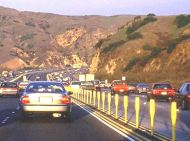4/12/2006
Carpooling Drops as US Expands HOV Lane NetworkDespite the increased construction of HOV lanes, carpooling is on the decline.

Over the next decade, the number of lane miles devoted to high-occupancy vehicles (HOV) will nearly triple as census data show Americans rejecting carpools in increasing numbers. Currently, HOV restrictions apply to 1285.3 lane miles of road across the country. That number will grow to 3225.3 over the next decade as ongoing road projects are completed[1]. The number of roads devoted to HOV projects has increased in every year since the early 1980s for the stated purpose of encouraging carpooling. The opposite has occurred.
Carpooling decreased 9.8 percent between 2000 and 2004, according to the latest available census data.[2] Over the same five year period, more people have hit the roads with a 6.5 percent increase in passenger travel by automobile[3].
A 2005 report by researchers at the University of California, Berkeley and California State University, East Bay suggests that HOV lanes increase congestion. Another study by the Texas Transportation Institute showed carpool lanes caused a 41-56 percent increase in accidents in HOV lanes without a physical barrier separating them from general purpose traffic.
References:
- Federal Highway Administration HOV facility finder
- US Census Bureau: 2004 American Community Survey (46k PDF)
- Bureau of Transportation Statistics


